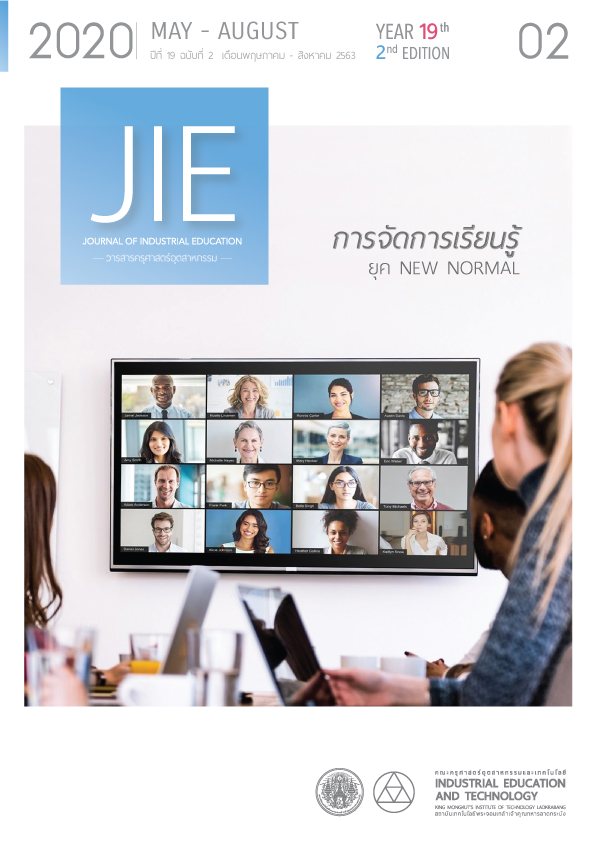ACHIEVEMENT WITH MIAP TEACHING METHOD VIA WEB – BASED INSTRUCTION ON CONDITIONS DESIGN FOR CERTIFICATE LEVEL
Keywords:
The computer-assisted instruction with the game strategy, Board game, MIAP teaching method, Achievements testAbstract
This research aimed 1) to develop the lesson management plan using MIAP teaching method via web-based instruction on conditions design; 2) to develop the computer-assisted instruction using a game strategy on conditions design with good quality and efficiency; and 3) to compare the achievement before and after using MIAP teaching method together with the computer-assisted instruction with the game strategy on conditions design of the second year students studying of a vocational certificate level. The samples used were the second year students studying in the Information Technology Department of a Vocational Certificate Level in Phra Nakhon Sri Ayutthaya Technology College. The samples were selected by using sampling techniques with two groups. The research instruments were 1) the lesson management plan using MIAP teaching method via web-based instruction on conditions design; 2) the computer-assisted instruction with the game strategy on conditions design; and 3) the 30 achievements test questions having the consistency (IOC) with the average of 0.67 – 1.00, the difficulty with the average of 0.20 – 0.55, the discrimination with the average of 0.21 – 0.76, and the reliability was 0.938. The research results showed that 1) the quality of the lesson management plan using MIAP teaching method via web based instruction on conditions design has good level (mean values = 4.59, standard deviation values = 0.17); 2) the quality of the computer-assisted instruction with the game strategy on conditions design with content topic has medium level (mean values = 3.70, standard deviation values = 0.50), and design technique has good level (mean values = 4.80, standard deviation values = 4.80); 3) the lesson via network on conditions design has efficiency E1/E2 = 85.02/84.90; and 4) the achievement of students after studying with the computer-assisted instruction with the game strategy on conditions design is higher than before studying, with statistically significance at 0.05 levels.
References
Ministry of Education. 2008. National Education Act B.E. 2551 (A.D. 2008). Retrieved June 13, 2019, from http://www.moe.go.th/main2/plan/p-r-b42-01.htm
Ministry of Education. 2019. Innovation Area Act B.E. 2562 (A.D. 2019).Retrieved September 23, 2019, from http://www.ratchakitcha.soc.go.th/DATA/PDF/2562/A/056/T_0102.PDF
National Science and Technology Development Agency. 2008. Application of information trchnology in teaching and learning Retrieved July 15, 2019, from https://www.princess-it.org/images/book/ict_integration.pdf
Office of Vocational Education Commission. 2008. The manual to creating a learning management plan focusing on efficiency.Retrieved July 25, 2019, from http://bsq2.vec.go.th/document/doc3.html
Wuttichai Prasansoi. 2000. Computer Assisted Instruction : Innovation for Education. Bangkok: P. J. Printing. Partnership Ltd.
Raweewat Siliban. 2010. “Guidelines for writing quality learning management plans.” Journal of the Ministry of Education. 2(11) : 19 – 23.
Sayamon Insaart. 2018. The design E-Learning for Develop advanced thinking skills. Bangkok : Public Company Limited
Chaiyong Brahmawong. 1997. Instructional System. Bangkok : Chulalongkorn University.
Office of the Basic Education Commission. 2016. The Basic Education Core Curriculum B.E. 2551 (A.D. 2008). Retrieved June 18, 2019, from http://academic.obec.go.th/newsdetail.php?id=75
Waralee Siripiyadtum. 2015. The Devolopment of Learning Achievement and Problem Solving Ability for Grade 12 Student by Using Project – Based Learning Activiites. Journal of Industrial Education. 14(2). P. 221 – 227.
Pittayanan Jatunarapit. 2016.The Inquiry Learning Model to Develop The Achievement on Conceptual Model of Upper Secondary Princess CHULABHORN’s College Chonburi. Journal of Industrial Education. 15(1). P. 219 – 68.
Settawoot Molanil. 2016. The Blended Learning on C Programming for Grade 9 in DEBSIRIN School. Journal of Industrial Education. 15(2). P. 10 – 17.
Narong Yhachammee. 2015. Development of Web Based Instruction for Review on Text Input and Create Table on Webpage. Journal of Industrial Education. 14(1). P. 63 – 68.
Patsarit Maneekeaw. 2015. Development of Web – Based Instruction for Review on Process Management System in Operation System for Higher Vocational Certificate Student. Journal of Industrial Education. 14(2). P. 132 - 138
Monchai Tiantong. 2002. Courseware design and development software for Computer Assisted Instruction. Textbook production center. King Mongkut’s University of Technology North Bangkok.
Sawitree Hongsa. 2017. Development of STEM Leaning with Web – Based Instruction on Robot Motion Control for High School. Journal of Industrial Education. 16(2). P. 18 – 24.
Kajornsak Masaart. 2017. A Development of Web – Based Instruction Based on Cooperative Learning Using Jigsaw Technique on Universe for Grade 9 Student. Journal of Industrial Education. 16(2). P. 40 – 47.
Anirut Buarapha. 2017. The Development of Web – Based Instruction on Web Creation by HTML Language for Vocational Certificate Level. Journal of Industrial Education. 16(2). P. 48 – 54.
Siwalee Minsakorn. 2016. The Development of Web – Based Instruction for Review on The Topic of Question Words for Grade 5 Student. Journal of Industrial Education. 15(3). P. 60 – 66.
Downloads
Published
How to Cite
Issue
Section
License
"The opinions and contents including the words in papers are responsibility by the authors."
"ข้อคิดเห็น เนื้อหา รวมทั้งการใช้ภาษาในบทความถือเป็นความรับผิดชอบของผู้เขียน"



